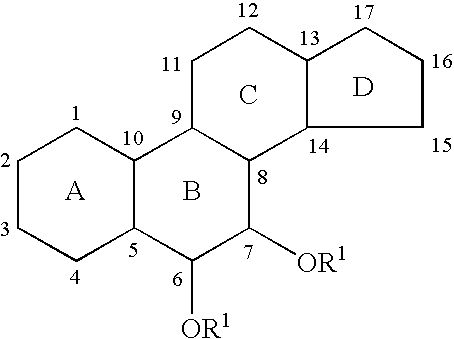6,7-Oxygenated steroids and uses related thereto
a technology of steroid compound and oxygen, applied in the field of steroid compounds, can solve the problems of limited use, minimal asthma control, and low use rate of oral steroids in the control of asthma
- Summary
- Abstract
- Description
- Claims
- Application Information
AI Technical Summary
Benefits of technology
Problems solved by technology
Method used
Image
Examples
example 1
The Steroid 3β,4α,6α,7β,17β-pentahydroxy-5α-androstane (237) can be Synthesized According to the Reaction Sequence Illustrated by Scheme 55
[0642]
[0643]Commercially available 4-androsten-3,17-dione (1) (20.0 g, 62.8 mmol) is stirred with ethylene glycol (10 mL) and a catalytic amount of p-toluenesulfonic acid (1.0 g, 5.2 mmol) in benzene (500 mL) at reflux under nitrogen for 26 hours (Scheme 56). The water generated by the reaction is removed during this time using a Dean-Stark apparatus. The mixture is then cooled to room temperature and Et2O is added. The mixture is washed with sodium bicarbonate, then water and dried over magnesium sulfate. Filtration and concentration gives a pale yellow solid that is washed with methanol to give the diketal 2 as a white powder (14.6 g, 39.0 mmol, 62%). A monoketal byproduct (5.13 g, 15.0 mmol) is recovered from the filtrate and recycled. The overall yield, accounting for the byproduct, is 86% of diketal 2.
[0644]Allylic oxidation at the C7 positi...
example 2
The Steroid 3α,4α-epoxy-6α,7β,17β-trihydroxy-5α-androstane (239) can be Synthesized According to the Reaction Sequence Shown in Scheme 59
[0658]
[0659]3α,4α-Epoxy-6α,7β,17β-trihydroxy-5α-androstane (239) can be produced from intermediate 10 in the synthesis of 3β,4α,6α,7β,17β-pentahydroxy-5α-androstane (258) (Scheme 60). A solution of compound 10 (111 mg, 0.234 mmol) in THF (4 mL) is transferred to a flask containing lithium metal in liquid ammonia (6.4 mg in 10 mL) at −78° C. under argon. After 30 minutes at −78° C., isoprene (0.5 mL) is added to destroy the excess lithium. The mixture is warmed to room temperature and the solvent is evaporated in vacuo. The residue is dissolved in THF (5 mL) and cooled to −78° C., then ClP(O)(OEt)2 (0.044 mL, 0.30 mmol) is added and the mixture is stirred for 1 hour. Water and dichloromethane are added, the mixture acidified, and the aqueous layer extracted with dichloromethane and Et2O. The combined organic layers are washed with water and dried ov...
example 3
The Steroid 3α,4β,6α,7β,17β-pentahydroxy-5α-androstane (241) can be Synthesized According to the Following Reaction Sequence (Scheme 61)
[0664]
[0665]The synthesis of 3α,4β,6α,7β,17β-pentahydroxy-5α-androstane (241) is carried out to the intermediate 238 using the same conditions as in the synthesis of 3α,4α-epoxy-6α,7β,17β-trihydroxy-5α-androstane (239). The subsequent epoxide ring opening with concurrent removal of the acetonide functionality (Scheme 62) is achieved by heating with glacial acetic acid to yield compound 146, which contains an acetoxy functionality at C4. To a flask containing compound 238 (18.5 mg, 0.038 mmol) is added acetic acid (0.30 mL). The mixture is stirred with heating at 60° C. for 24 hours, then at room temperature for 2 days. The acetic acid is removed in vacuo to give compound 146 in 93% yield (18 mg, 0.036 mmol).
[0666]Deprotection of the C4 hydroxyl using K2CO3 in refluxing methanol, and deprotection of the C17 hydroxyl using TBAF yields the pentahydroxy...
PUM
| Property | Measurement | Unit |
|---|---|---|
| volume | aaaaa | aaaaa |
| temperature | aaaaa | aaaaa |
| temperature | aaaaa | aaaaa |
Abstract
Description
Claims
Application Information
 Login to View More
Login to View More - R&D
- Intellectual Property
- Life Sciences
- Materials
- Tech Scout
- Unparalleled Data Quality
- Higher Quality Content
- 60% Fewer Hallucinations
Browse by: Latest US Patents, China's latest patents, Technical Efficacy Thesaurus, Application Domain, Technology Topic, Popular Technical Reports.
© 2025 PatSnap. All rights reserved.Legal|Privacy policy|Modern Slavery Act Transparency Statement|Sitemap|About US| Contact US: help@patsnap.com



